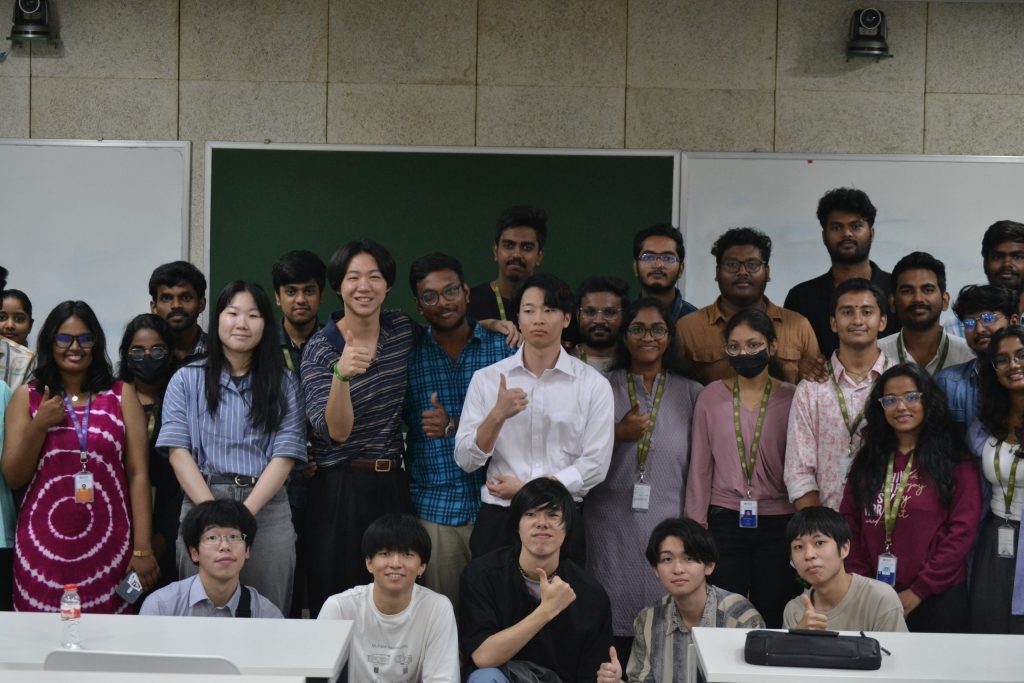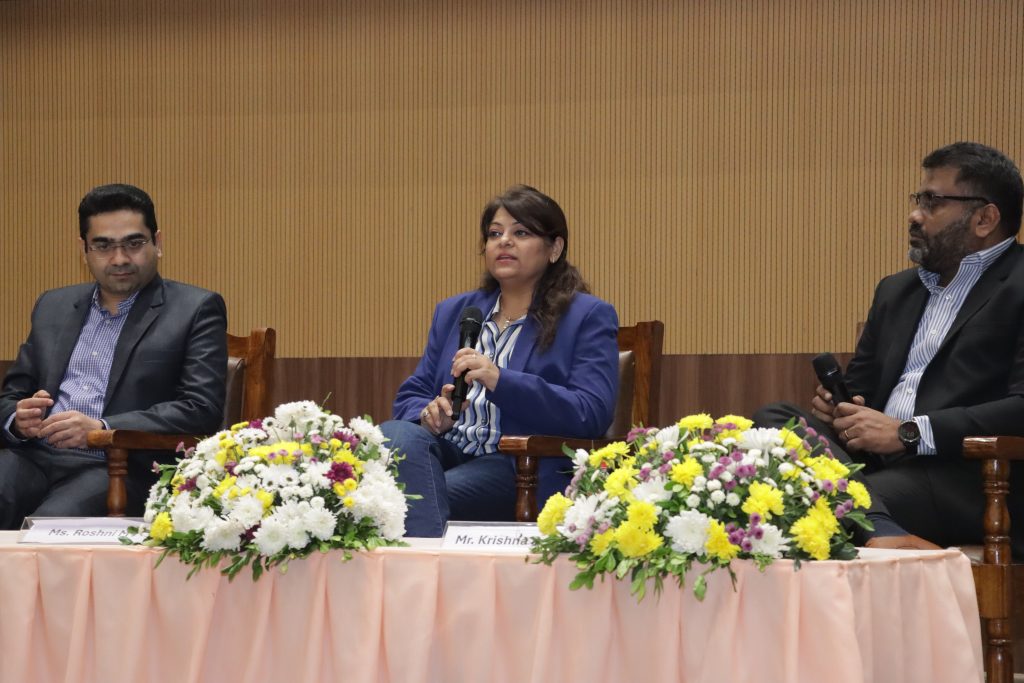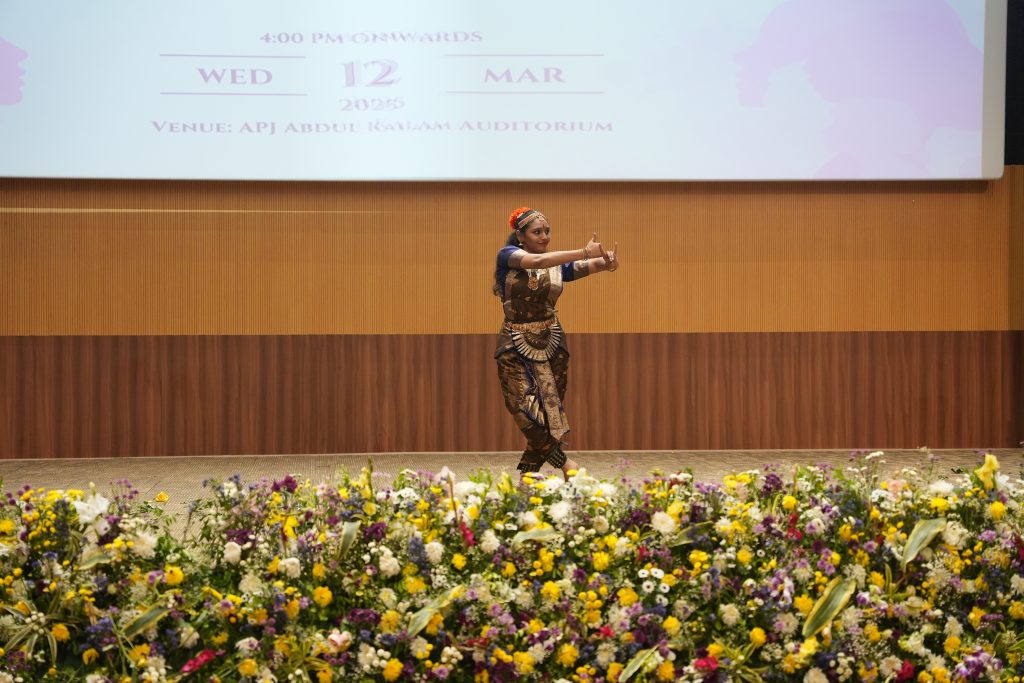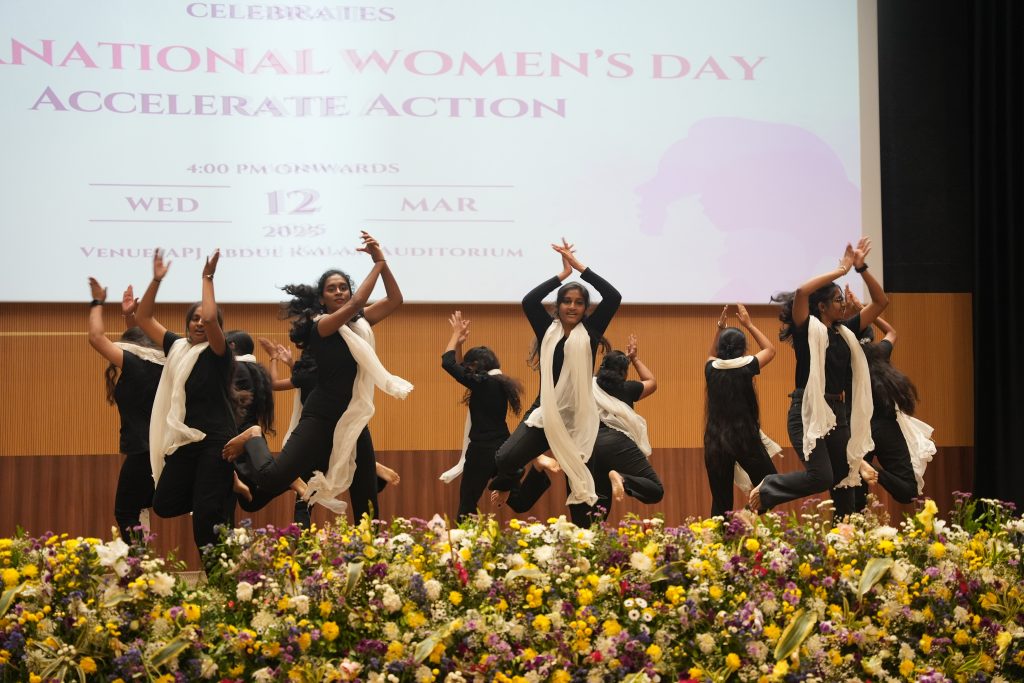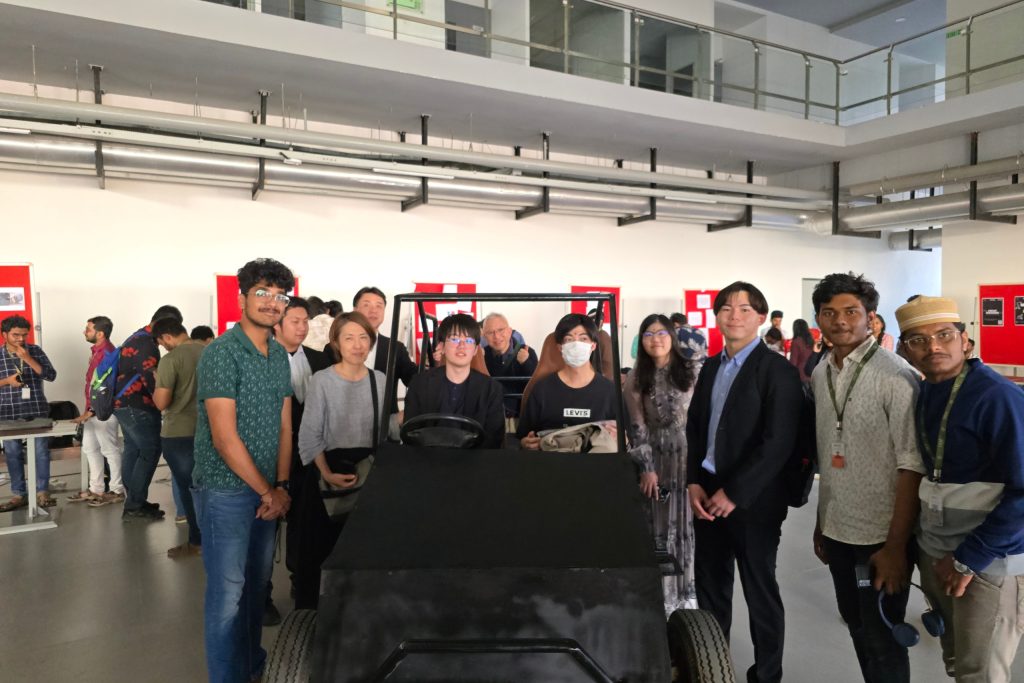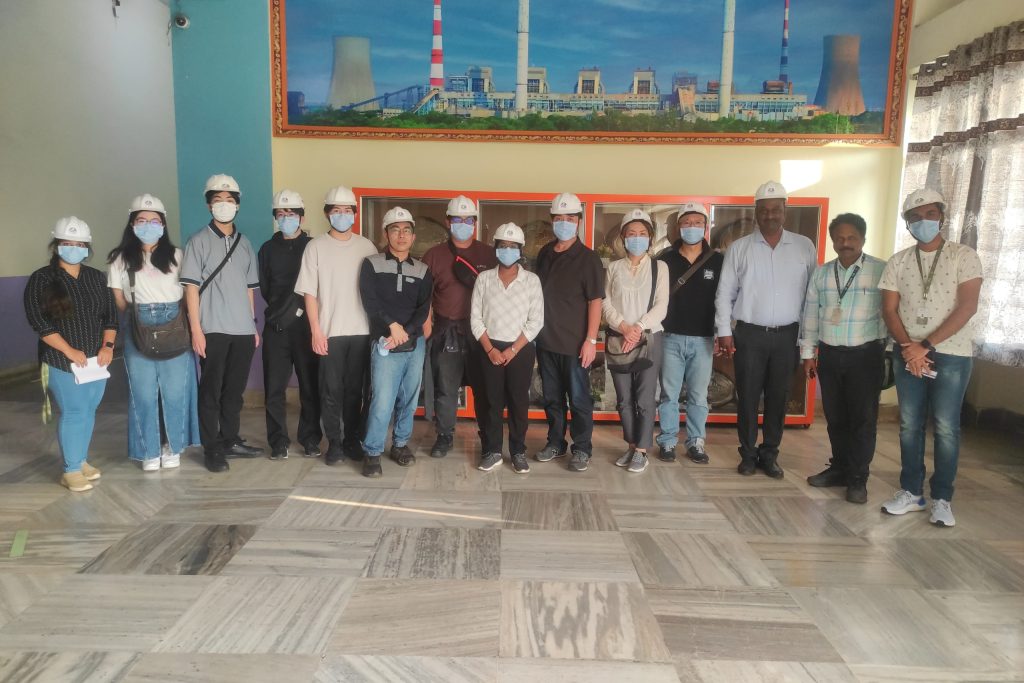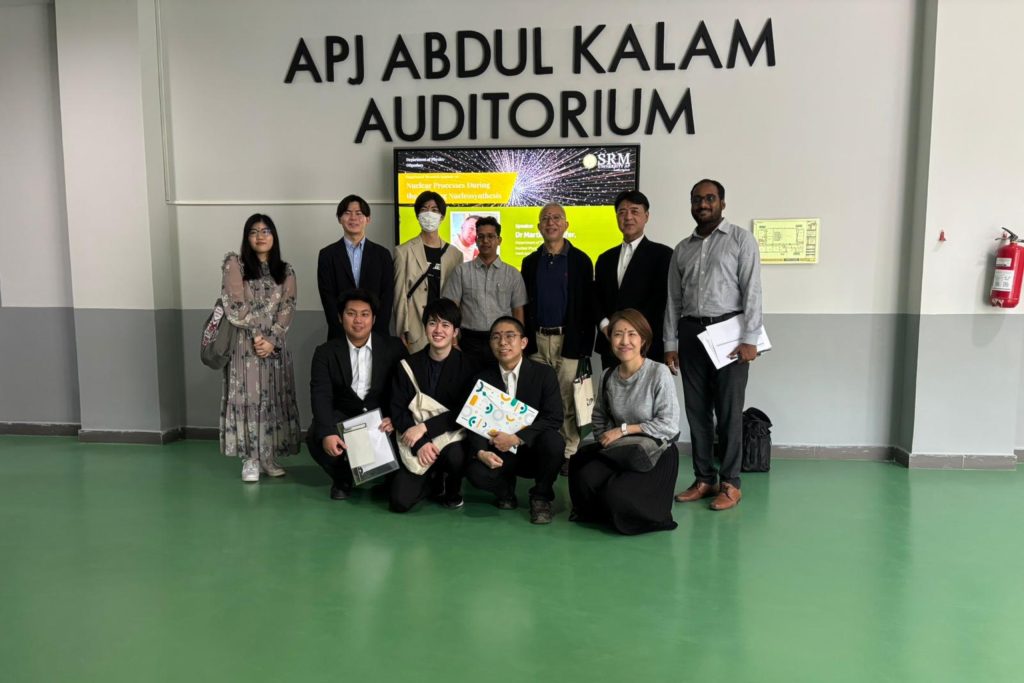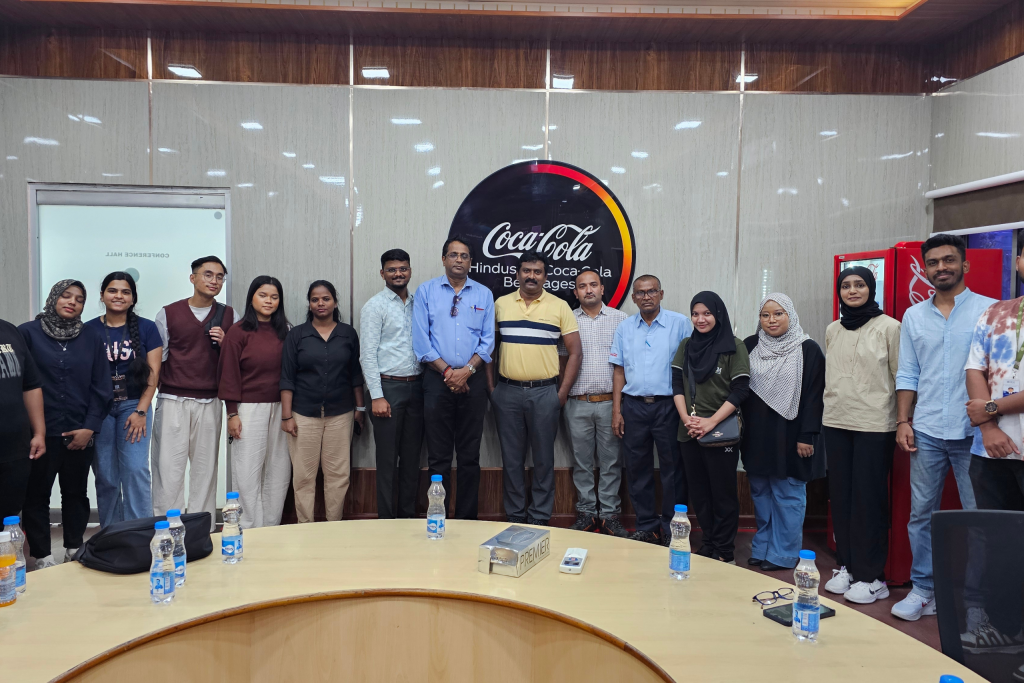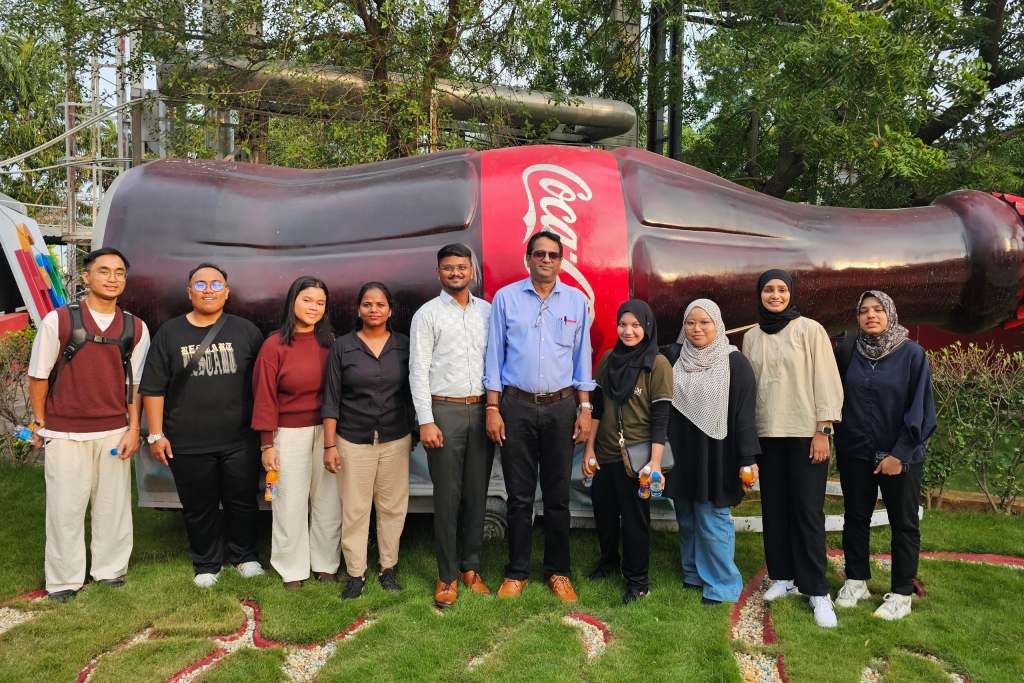Dr Amit Chakraborty and Scholar Publish their Research in Nature Index Journal

Dr Amit Chakraborty, Assistant Professor in the Department of Physics and Ms Shreecheta Chowdhury, PhD Scholar, have co-authored a research paper titled “Boosted top tagging through flavour-violating interactions at the LHC”, which has been published in the European Physical Journal C (Nature Index), Q1 Journal having an impact factor 4.2.
Their research focuses on identifying a rare process involving the top quark, one of the heaviest particles. In this rare decay, the top quark transforms into a charm quark and a Higgs boson, which then breaks down into two b quarks. The team uses the data collected at the Large Hadron Collider (LHC), the world’s largest particle smasher, and employs Machine Learning techniques to investigate the possibility of understanding these collision events and identifying signatures of physics Beyond the Standard Model.
Abstract
This paper describes a method for detecting a rare top quark decay into a charm quark and a Higgs boson (H), which decays further into b quarks, at the Large Hadron Collider (LHC), and introduces a tagging algorithm to identify boosted tops using large-R jets containing b- and c-tagged elements. We consider the associated production of the top quark with a W-boson and identify different observables to discriminate the signal from the Standard Model (SM) background events. Although our model with improved jet substructure methods outperforms existing approaches to tag such rare decay tops, the improvement in the New Physics reach in terms of t → cH branching ratio is marginal, even at the high luminosity run of LHC, compared to the existing limits from the LHC 13 TeV data. Additionally, the paper utilizes SHAP, a Game Theory-based method, to analyse the contribution of each observable to the classification of events, offering valuable insights into the classifier.
Future Research Plans
The team plans to explore Beyond Standard Model (BSM) physics through collider phenomenology. Leveraging the Higgs boson as a portal, they aim to investigate its potential role in dark matter interactions, neutrino mass generation, and possibly being part of a larger scalar sector. Additionally, Dr Chakraborty will delve into ultra-light particle searches and develop novel jet physics techniques using advanced Machine Learning (ML) algorithms for particle identification and classification. A crucial aspect of his work will be creating testable search strategies, ensuring direct comparison with experimental data from current and future colliders.
- Published in Departmental News, News, Physics News, Research News
Chemistry Student Secures Prestigious HEST Scholarship

Department of Chemistry is proud to announce that Mr M V R Akshay Sampath, 3rd year BSc. Chemistry student has been selected for the HEST Scholarship, India’s largest Higher Education Scholarship Test powered by WeMakeScholars, an organisation funded and supported by the Ministry of Electronics & Information Technology (MeitY), Govt. of India under the ‘Digital India’ campaign. Through this scholarship, Mr Sampath is eligible for scholarship funding of ₹3 lakhs, which can be utilized towards tuition fees, academic expenses, or travel costs for higher education.
Along with academics, Akshay is working in the functional nanomaterials laboratory under the supervision of Dr Sabyasachi Chakrabortty and in computational chemistry research under the supervision of Dr Baswanth V S Oruganti, Chanakya University, Bangalore. This opportunity significantly supports his aspirations for higher education and research in the branches of bio-photonics and material science in the top research-intensive universities globally in countries like Germany, UK, Ireland, and the USA.
- Published in Chemistry-news, Departmental News, News
Film Gala 2025: Exploring Novel Media of Storytelling

The Film Gala 2025, organised by the CineMates Club of SRM AP, was inaugurated with a formal ceremony that marked a prestigious two-day celebration dedicated to the art of cinema, narrative excellence, and creative expression. This distinguished event established a professional forum for filmmakers, artists, and cinema enthusiasts from across the nation to participate in intellectual discourse, competitive showcases, and cultural exhibitions.
The ceremony was honoured by the presence of Mrs Tejaswi Podapati Macharapu, Chairperson of the AP State Creativity and Culture Commission, Government of Andhra Pradesh, who served as the Chief Guest. She was accompanied by Mr Sujith Kalluri, Chief Club Advisors, distinguished faculty members, Founders and Alumni of CineMates, and official representatives from the organising committee.
The keynote address by Chief Guest Mrs Tejaswi Podapati Macharapu constituted the ceremony’s centrepiece. She delivered a comprehensive discourse on cinema’s transformative role in contemporary society. Drawing from her academic experiences, she emphasised the importance of integrating creative pursuits with scholastic endeavours. Mrs Tejaswi noted that India maintains its position as the world’s foremost film-producing nation, with an annual output exceeding 2,000 cinematic productions, thereby presenting substantial opportunities for aspiring filmmakers. She further emphasised that students from diverse academic disciplines, including engineering, possess the analytical acumen and creative capabilities necessary for success in the film industry.
To reinforce her message, Mrs Tejaswi referenced distinguished individuals from various professional domains, including politics, athletics, and the arts, underscoring how perseverance and passion are fundamental elements of professional achievement. She concluded her address by expressing admiration for the Film Gala’s established legacy and commended SRM AP for its institutional commitment to advancing artistic initiatives.

The ceremony featured classical dance performances by Ms. Preeti and Ms. Deepthi, who demonstrated the artistic interpretation of narrative through choreographed movement, exemplifying the intersection of traditional cultural expression and contemporary storytelling techniques.
A significant component of the inauguration was the formal announcement of the 24-Hour Filmmaking and Editing Challenges. The Visual Chase competition specified that participants create a two-minute video exploring the theme “Nature Speaks to Me,” while the Classic Cut competition challenged contestants to produce a trailer for the film ‘Kalki 2898 A.D.,’ with a maximum duration of 2 minutes and 30 seconds.
The inaugural ceremony concluded with a comprehensive presentation of the day’s scheduled activities, including curated short film screenings, a poetry recitation session, and an evening film presentation. The enthusiastic participation from attendees signified the successful launch of Film Gala 2025, establishing an auspicious foundation for what promised to be an intellectually stimulating and culturally enriching festival.
The event received generous sponsorship from esteemed organisations including Sastri Balm, AWEC Consultancy, IVY Overseas, ATHER, Vastrakala Shopping Mall, Picxy, Harivillu Promoters and Developers Pvt. Ltd., V1 Overseas Careers Pvt. Ltd., and GTR Solar Power. Their valued support facilitated the creation of a platform where emerging talents could demonstrate their artistic vision and technical expertise.
- Published in Departmental News, News, student affairs news, Students Affairs Events
Global Immersion Programme at Middlesex University, Dubai
 The Directorate of International Relations and Higher Studies successfully organised a Winter Global Immersion Programme in collaboration with Immersion Global at Middlesex University Dubai in 2024. Two of our students, one from BBA. – Business Administration (Hons.) and another from the Department of Computer Science and Engineering (CSE), participated in this enriching experience from November 5 to November 16, 2024
The Directorate of International Relations and Higher Studies successfully organised a Winter Global Immersion Programme in collaboration with Immersion Global at Middlesex University Dubai in 2024. Two of our students, one from BBA. – Business Administration (Hons.) and another from the Department of Computer Science and Engineering (CSE), participated in this enriching experience from November 5 to November 16, 2024
An incredible opportunity for Indian students to travel, explore, and learn! International University Immersion Programmes are thoughtfully curated at some of the world’s top universities and institutions to provide a global edge in learning and set students up for success.
In the Winter Immersion Programme 2024, organised by Immersion Global, SRM AP University students embarked on a transformative two-week journey. They had the unique privilege of participating in a prestigious programme at Middlesex University Dubai.
Our students immersed themselves in the vibrant technological hub of Dubai, UAE, gaining hands-on experience and valuable insights into cutting-edge advancements.
Programme Highlights:
- Explored innovative business models and entrepreneurship.
- Acquired skills in Design Thinking, Digital Marketing, and the fundamentals of Management & Financial Studies.
- Attended specialised courses on Accounting, Marketing Strategies, and Leading in a Cross-Cultural Context.
- Engaged in sessions on Business and Sustainability, Leading and Managing Change, and understanding the integration of AI in Business Leadership theories.
Alongside their academic endeavors, students were captivated by Dubai’s technological innovations and architectural marvels. Their journey also took them to the vibrant cities of the UAE—Dubai, Sharjah, and Abu Dhabi—where they embraced cultural diversity, explored local cuisines, and overcame barriers of tradition and innovation, further enriching their global outlook.
This exceptional experience reflects not only the outstanding leadership and technical expertise of our student Kesava but also the world-class education and unwavering support provided by SRM University-AP. We are incredibly proud of Kesava and his team and eagerly anticipate their future achievements in the realm of remote sensing and beyond.
- Published in Departmental News, IR-News, News
Discover India 2025: SRM AP Host Delegates from Ryukoku University
 The Directorate of International Relations & Higher Studies welcomed the students and faculty from Ryukoku University, Japan for the “Discover India 2025 ” programme.
The Directorate of International Relations & Higher Studies welcomed the students and faculty from Ryukoku University, Japan for the “Discover India 2025 ” programme.
A 4-day Discover India 2025 programme conducted by the Directorate of International Relations and Higher Studies was inaugurated by Dr K A Sunitha – Associate Professor and Head, Department of Electronics and Communication Engineering alongside Dr Mahesh Kumar Ravva – Associate Professor and Assistant Dean Research; Dr Ishita Sar – Assistant Professor from Paari School of Business and Prof. P Vivekananda Shanmuganathan – Professor, Mechanical Engineering. “Discover India 2025” is a flagship initiative of the university to promote India’s cultural and knowledge traditions.
Dr Sudeshna Saha, Assistant Director of International Relations and Higher Studies, received the international students at the grand inaugural ceremony of the programme. Students participated in various short courses on research area, visits were made to Electronic Cooling Lab, Computer Science and Engineering labs, Research Lab’s, Civil Engineering Labs and Drone and Centre for Geospatial Technologies.
A discussion was held with the IR & HS team and with the leadership team regarding various mobility programmes, including Student and Faculty Exchange, Transfer Programmes, Joint Research initiatives, and opportunities for mutual collaboration between Ryukoku University and SRM University-AP.
An interactive session was organised for Destination Japan students currently learning Japanese at SRM University-AP, supported by SRM Global. Professors Otsu Hirotaka & Prof. Kimura Mutsumi delivered an engaging presentation on Ryukaku University, highlighting job and internship opportunities in Japan. The session provided a platform for Destination Japan students to interact with peers learning Japanese. Over 52 students actively participated, making the event a resounding success.
As part of the “Discover India” programme, SRM University-AP organised an industrial visit to HCL Technologies Limited, Vijayawada, on February 26, 2025. A total of 15 participants, including professors, staff, and students from Ryukoku University, Forum Engineering, and SRM University-AP, attended. The Japanese group had a valuable experience, interacting with HCL’s Health Center and the Head of Training and Recruitment team.
Participants visited landmarks such as the Dhyana Buddha statue, Bhavani Island and the Kanaka Durga Temple in Vijayawada, deepening their appreciation of Indian culture.
- Published in Departmental News, IR-News, News
Department of Management Hosts Event on Work life Balance
 SRM University-AP hosted the second edition of its flagship event, Trending Issues in Management organised by the Department of Management at the Paari School of Business. The theme of the event -“Work Life Balance”, was inspired by the provocative remarks from prominent corporate leaders such as Narayan Murthy and S N Subrahmanyan.
SRM University-AP hosted the second edition of its flagship event, Trending Issues in Management organised by the Department of Management at the Paari School of Business. The theme of the event -“Work Life Balance”, was inspired by the provocative remarks from prominent corporate leaders such as Narayan Murthy and S N Subrahmanyan.
The business event brought together industry experts, including Mr Krishna Repaka, Vice President Deloitte India; Dr Deepak Bidla, Director HR, Ex—Quadrant; Ms Roshni M J, Senior Director, Netenrich Inc., as panellists; Dr Chinta Doshi, Senior Director HR Nium, as the keynote Speaker; and Prof. Bharadwaj Sivakumaran, Dean Paari School of Business, as the moderator for the event.
Dr Chintan Doshi, set the tone for the event through his keynote address. He highlighted eight pointers that stressed on the fundamental topic of why one must work. Mr Doshi stated that money of course is one parameter for why one should work, but respect, prestige, being an inspiration to someone and working for credibility and reputation are other factors that surpass the monetary benefits.
During the panel discussion, the industry experts unanimously emphasised the need for work-life balance, but they also echoed that one must strike a balance between work and personal life. Ms Roshni emphasised that team and organisation are important factors that need to be brought into consideration. She stated team deadlines and individual interest are considering factors at times.
Mr Krishna Repaka, Vice President at Deloitte India, remarked, “As students, we have all dedicated those extra hours to hard work during our examinations when the need has risen, we never backed out because it disrupted our personal life balance. Similarly when need rises we all need to pitch in to put that extra effort.” Adding to this Mr Deepak Bidla stated, “Collaboration is key, but more than extended work hours productivity is what matters.”
The panellist discussed the impact of technology, which stimulated mixed responses. The panel stated that technology is an enabler, but how one consumes it is an important factor. The panel discussion also examined the COVID-19-induced work-from-home culture and its continuation post-COVID-19. The panel also agreed that the hybrid model of work has been a boon in many ways for those who can. While it is a boon, the mindset one has while working from home also matters.
The event concluded by emphasising a crucial balance between professional commitment and mental well being. While factors like the need to unwind and relax are important, it is also not important to consider factors such as commitment, productivity and accountability at work.
- Published in Departmental News, News, Paari Current Happenings
Celebrating Women: SRM AP Observes International Women’s Day
 Smt. Madhuri Nallapaneni, Group Director, Cadence-Invecas India graced the International Women’s Day celebration held at SRM University-AP. The celebration was organised by the Directorate of Student Affairs and featured esteemed dignitaries including SRM Group Advisor Prof. V S Rao alongside Vice Chancellor Prof. Manoj K Arora; Registrar Dr R Premkumar; Associate Directors Ms Revathi Balakrishnan and Dr Ramesh Vaddi; Deans of the 3 schools, Directors, Faculty, Staff and students.
Smt. Madhuri Nallapaneni, Group Director, Cadence-Invecas India graced the International Women’s Day celebration held at SRM University-AP. The celebration was organised by the Directorate of Student Affairs and featured esteemed dignitaries including SRM Group Advisor Prof. V S Rao alongside Vice Chancellor Prof. Manoj K Arora; Registrar Dr R Premkumar; Associate Directors Ms Revathi Balakrishnan and Dr Ramesh Vaddi; Deans of the 3 schools, Directors, Faculty, Staff and students.
Vice Chancellor Prof. Manoj K Arora in his address stated, “A woman in her lifetime assumes many roles, the role of a mother, daughter, wife, sister, friend, a daughter-in-law, a mother-in-law and more. She is the ‘Janani’ (nurturer) and deserves utmost respect.”
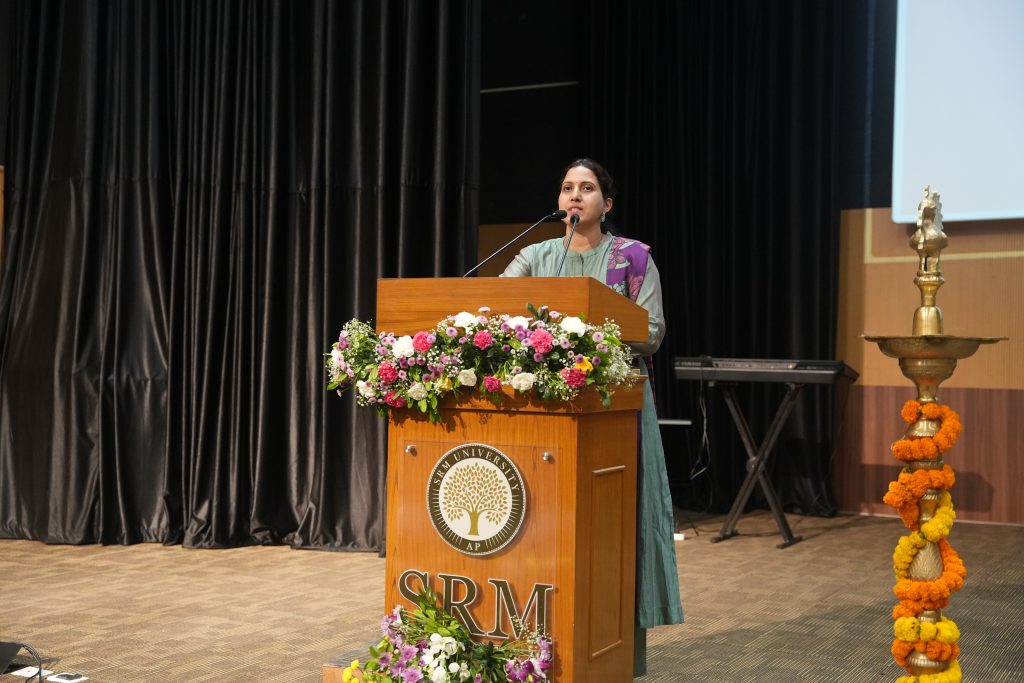
He also referenced the recent conference on Population Dynamics, wherein the concept of population management emphasised the welfare of women to effectively manage population. Prof. Arora also stressed on the theme of this year’s women’s day celebration – “Accelerate Action”.
During her address, Ms Nalapaneni remarked that, “Women’s day celebration should not be just that, beyond mere celebration it should be a checkpoint for us to analyse the challenges women face and to overcome them.” She also added, our precursors have paved the way for us to be here today. She encouraged everyone present to be a lifetime learner, because life never stops teaching.
Ms Nalapaneni empahsised the need to continue advocating for women’s empowerment and support other women because when a woman is empowered the entire society is empowered. The celebration featured several engaging games including tug of war, push-up challenge, debate competition, cooking without fire and arm wrestling. The winners of the competition were felicitated.
 The competition winners were presented with certificates. The highlight of the celebration was the presentation of the Uttama Mahila Prathibha Award, an initiative of Advisor Prof. V S Rao Foundation. The awards were presented across various categories such as landscaping, security, mess and so on. The event also featured a heart touching video featuring the women of SRM AP and honouring their achievements and contributions.
The competition winners were presented with certificates. The highlight of the celebration was the presentation of the Uttama Mahila Prathibha Award, an initiative of Advisor Prof. V S Rao Foundation. The awards were presented across various categories such as landscaping, security, mess and so on. The event also featured a heart touching video featuring the women of SRM AP and honouring their achievements and contributions.
SRM University-AP remains committed to empowering women and looks forward to organising more events that celebrate and support women’s contributions within the community.
- Published in Departmental News, News, student affairs news
Discover India 2025: SRM AP Hosts Japanese Delegation
 The Directorate of International Relations & Higher Studies welcomed the students and faculty from Nihon University and Forum Engineering, Japan to the “Discover India 2025” programme.
The Directorate of International Relations & Higher Studies welcomed the students and faculty from Nihon University and Forum Engineering, Japan to the “Discover India 2025” programme.
A 4-day event, the Discover India 2025 programme conducted by the Directorate of International Relations and Higher Studies was inaugurated by the honourable Vice Chancellor of SRM University-AP, Prof. Manoj K Arora, in the presence of Prof. C V Tomy, Dean – School of Engineering and Sciences; Prof. Vishnupad, Dean – Easwari School of Liberal Arts; Dr Raviteja KVNS, Assistant Professor & Head-Department of Civil Engineering; Prof. P Vivekananda Shanmuganathan, Professor-Mechanical Engineering; and Dr Pranav R T Peddinti, Assistant Professor-Department of Civil Engineering. “Discover India 2025” is a flagship initiative of the university to promote India’s cultural and knowledge traditions.
Dr Sudeshna Saha, Assistant Director of International Relations and Higher Studies, received the international students at the grand inaugural ceremony of the programme. Students participated in various short courses on research area introduction Mechanical Engineering/ Lab and Centre Visit, Electronic Cooling Lab, Computer Science and Engineering and visit to Research Lab’s, Civil Engineering Labs and Drone and Geospatial technologies. Dr Pranav R T Peddinti and Mr Balu from the department of Civil Engineering gave presentations on Robotics and Prof. Vivekanandan from the Department of Mechanical Engineering offered an overview on Additive Manufacturing & Bio Printing Materials.
Discussion were held with the IR & HS team and with the leadership team regarding various mobility programmes, including Student and Faculty Exchange, Transfer Programmes, Joint Research initiatives, and opportunities for mutual collaboration between Nihon University and SRM University-AP.
An interactive session was organised for Destination Japan students who are currently learning Japanese at SRM University-AP. Prof. Toriizuka Takashi & Prof. Kamei Yasuko delivered an engaging presentation on Nihon University, highlighting job and internship opportunities in Japan. The session provided a platform for Destination Japan students to interact with peers learning Japanese. Over 63 students actively participated, making the event a resounding success.
The industrial visit saw participation from a total of 13 members, including 2 professors, 1 staff member , and 6 students from Nihon University and Forum Engineering, as well as 2 staff members and 2 students from SRM University-AP. As part of the “Discover India” programme, SRM University AP organised an industrial visit on February 06, 2025, for the Japanese delegation from Nihon University and Forum Engineering. The group visited the Dr Narla Tata Rao Thermal Power Station in Ibrahimpatnam. The power plant is one of the coal-based power plants of APGENCO.
The visit began with a brief introduction of the team, followed by a presentation on the Ibrahimpatnam Coal-Based Power Station. After the presentation, the group toured the entire power station, including the coal heating and cooling units, gaining an understanding of the coal-based power generation process and how electricity is supplied to the Vijayawada region.
- Published in Departmental News, IR-News, News
Universiti Teknologi PETRONAS (UTP)
 The Aadigyam Programme 2023 organized by the Directorate of IR & HS, SRM University-AP welcomed faculty and students from The Universiti Teknologi PETRONAS (UTP), Malaysia, for a 5-day immersive programme from Aug 16th to Aug 20th 2024.
The Aadigyam Programme 2023 organized by the Directorate of IR & HS, SRM University-AP welcomed faculty and students from The Universiti Teknologi PETRONAS (UTP), Malaysia, for a 5-day immersive programme from Aug 16th to Aug 20th 2024.
Aadigyan Indian immersion program was inaugurated by the honourable Vice Chancellor of SRM University-AP, Prof. Manoj K Arora, Bharadhwaj Sivakumaran, Jayaseelan Murugaiyan, Mr Sidharth Tripathy and Vishnupad. “Aadigyan India Immersion 2024” is a flagship initiative of the university to promote India’s cultural and knowledge traditions.
Students participated in various short courses on Future Prospects and Introduction – Design Thinking By Mr. Satya – PSB, Entrepreneurial Mindset. Introduction of Thinking Like an Entrepreneur dynamic sessions were held on entrepreneurship and innovation by Mr. Sidharth Tripathy, Introduction to Business Insight: Today and Beyond- Dr. Kamesh – PSB, Introduction to Digital Marketing Mastery Dr Rohit / Dr Md Asadul – PSB
This collaborative initiative also focused on promoting the rich heritage of Andhra Pradesh where the students from Malaysia were taken to experience the natural landscapes and cultural delicacies of the state.
Dr. Sudeshna Saha, Assistant Director of International Relations and Higher Studies, conducted a discussion with the IR & HS team and the leadership team on various mobility programs. The topics included Student and Faculty Exchange, Transfer Programs, Joint Research Initiatives, and exploring opportunities for mutual collaboration between Tokyo University and SRM University AP
The industrial visit saw participation from a total of 13 members, including 1 professor, and 7 students from UTP Malaysia, as well as 2 staff members and 2 students from SRM University AP.
As part of the 5 days Indian Immersion Program, SRM University AP organized an industrial visit on August 18th, 2024, for the Malaysia professor and students. The group visited the Coca-Cola factory, where they first interacted with the head of the department and watched an instructional video outlining the guidelines and safety precautions for the tour.
Following this, the students were taken to the simulation room, where they observed the production process of Thumbs Up and other flavored beverages. They then toured various sections of the plant to see how different drinks are bottled and packed.
The visit began with a brief introduction of the team, followed by a presentation on the Ibrahimpatnam Coal-Based Power Station. After the presentation, the group toured the entire power station, including the coal heating and cooling units, gaining an understanding of the coal-based power generation process and how electricity is supplied to the Vijayawada region.
They also got to visit the famous landmarks of Vijayawada, such as the Dhyana Buddha statue, Prakasham Barrage, etc.
- Published in Departmental News, IR-News, News
Discover India Programme
SRM University-AP welcomed Japanese faculty from “Toyo University from Japan”. rich c ultural landscape of India through the Aadigyan – Indian Immersion Program from february 21st to 24th, 2024. These 4-days program conducted by the Directorate of International Relations and Higher Studies was inaugurated by the honorable Vice Chancellor of SRM University-AP, Prof. Manoj K Arora. Aadigyan is a flagship initiative of the university to promote India’s cultural and knowledge traditions.
ultural landscape of India through the Aadigyan – Indian Immersion Program from february 21st to 24th, 2024. These 4-days program conducted by the Directorate of International Relations and Higher Studies was inaugurated by the honorable Vice Chancellor of SRM University-AP, Prof. Manoj K Arora. Aadigyan is a flagship initiative of the university to promote India’s cultural and knowledge traditions.
Our “Discover India Programme” is a transformative journey where innovation meets tradition. SRM University-AP unfolds its collaborative tapestry with Toyo University, #Japan. Witness the dawn of a new era in academia, brimming with opportunities that promise to revolutionize our educational landscape. We are honored to host our distinguished guests Prof. Akihiro Matsumoto, Dean of Science and Engineering, Toyo University, Prof. Sho Yokota, Department of Mechanical Engineering, Toyo University, Mr. Yutaka Kikuchi, Operating Officer, Forum Engineering Inc.
Who are steering the venture towards unparalleled educational milestones with Ms. Aditi Jain, Director IR and HS, SRMAP, Dr. Mannathan Subramaniyan, Associate Director IR and HS, SRMAP, Dr Jatindra Kumar Dash, Associate Dean in-charge – (Engineering) SEAS, Dr. Tousif Khan N, SMIEEE, MIE, Head of the Department, Electrical and Electronics Engineering, Dr. Vinod Kumar, Head Of Department – Mechanical Engineering, SRMAP.
This enlightening gathering was more than a meeting of minds; it was a fusion of cutting-edge research and shared visions. The delegates engaged intimately with our esteemed faculty and brilliant research scholars from the Mechanical and Electrical and Electronics Engineering Departments, sparking dialogues that promise to kindle innovative research collaborations.
Their exploration of our state-of-the-art research facilities provided a window into the advanced realm of EV Research Technologies at SRM University-AP. The visit illuminated the potential for groundbreaking advancements in sustainable technology, reflecting our commitment to pioneering solutions for a greener future.
The academic engagement was beautifully complemented by industry visits to Efftronics Systems Pvt Ltd and Hindustan Coca-Cola Beverages Pvt Ltd, where practical insights and real-world applications bridged the gap between theoretical knowledge and industrial praxis.
Culminating the visit, our guests were immersed in the rich tapestry of Indian culture, exploring the serene Amaravati Buddha Statue, the sacred Amareswara Swamy Temple, and the historic Durga Temple in Vijayawada. This cultural odyssey not only showcased the heritage of our region but also fostered a deeper mutual respect and understanding, enriching the fabric of our international collaboration.
As we reflect on these three days of intellectual exchange, cultural immersion, and visionary exploration, we are filled with hope and excitement for the future collaborations that will undoubtedly emerge from this fertile groundwork. We stand on the brink of a new dawn in global education, ready to innovate, inspire, and transform together.
- Published in Departmental News, IR-News, News



















